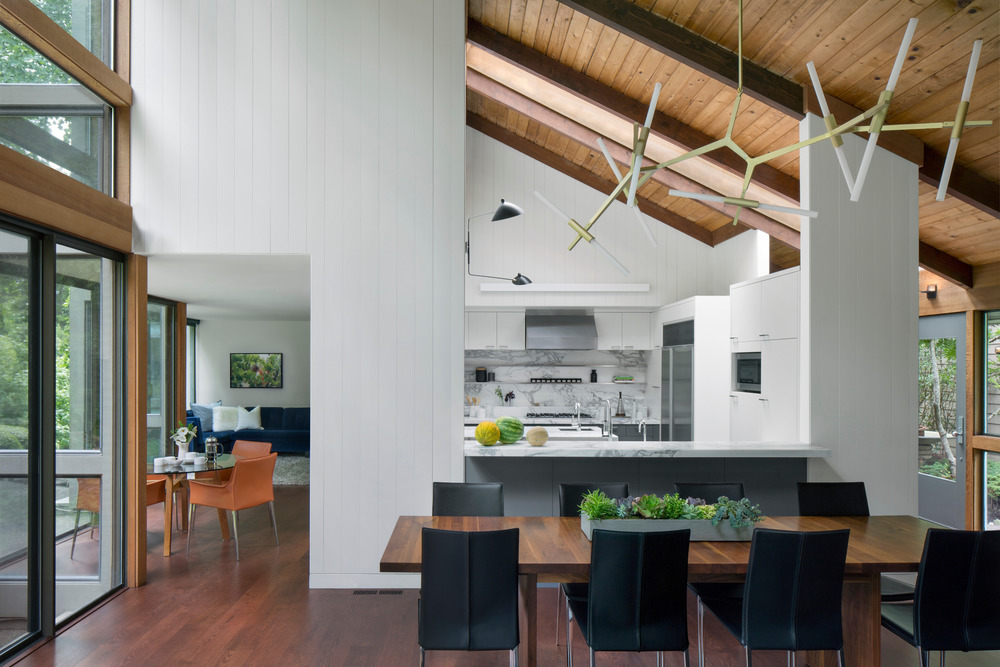Andrew Mann of Andrew Mann Architecture is known for the myriad ways he thoughtfully manipulates light within his body of work, while also maintaining a commitment to thoughtful craft details. The San Francisco-based architect expands the tradition of the Bay Area Style to contemporary needs, specifically inspired by the works of, and the precedent set by, earlier generations of architects such as Bernard Maybeck, Julia Morgan, William Wurster, William Turnbull, Jr., and Joseph Esherick. In his own practice, one sees a commitment to simple, rustic modern buildings that capture the play of natural light on the inside and the direct connection to the landscape on the outside.
Through the thoughtful placement of windows, doors, skylights, and clerestories, the firm’s work emphasizes three-dimensional forms by playing with light to define surfaces. At a detailed level, the team focuses on the innate characteristics of materials, specifically how they meet at surfaces and corners to create refined moments that celebrate crafted details.
An enduring desire for crisp lines and simple detail is paramount to the firm’s design philosophy, which is illustrated in these signature projects:
Meadow Estate
This residence done in collaboration with Niche Interiors captured the clients’ desires for a comfortable, casual home that integrates the indoors and outdoors with architecture that is light-filled, airy, and spatially rich. Sited along a creek and opening to a meadow, the oak-studded property provides rich and varied landscapes for outdoor activities. The key architectural and interior design moves to house, originally constructed in 1925, included adding porches that became an extension of interior rooms and creating a vocabulary of elements with modern detailing and clean simplified lines.
Modern Craftsman
Designed for an avid collector, this modern interpretation of Craftsman style architecture provides gallery space for the owner’s Native American artifacts, baskets, craftsman furniture, landscape paintings, and other decorative objects. The architecture is meant to be crisp and simple so as to highlight and bring those collections to the foreground. Its modern-ness is intended as a contrast to the traditional or intrinsic character of the furniture, artwork, and artifacts. The architecture is intended to create aesthetic hierarchy and provide focus to those elements in a gallery-like setting, allowing the owner to develop tableaus that can change over time, all the while creating a warm, comfortable, richly layered welcoming home.
Wine Country Estate
Situated in the heart of the Napa Valley floor, this private vacation compound is the perfect wine country retreat with spectacular views of the surrounding vineyards and mountains. The home is a contemporary take on the traditional country house with outdoor entertaining in mind. The estate’s residence and guesthouse are all open to simple, elegant, and lush private gardens complete with an outdoor pavilion large enough for the client to host wine tastings. Given the region’s natural beauty, the exterior spaces, such as the main porch with its ample trellis, were designed with care to capture the area’s spectacular modulation of light.
Sonoma Retreat
This weekend getaway for busy professionals looking to unwind and connect with nature creates a relaxing environment. While iconic and modern in form, the home—originally built in 1974—was in need of an interior refresh. A series of new interventions including a thoughtfully-updated kitchen, new bathrooms and stairs, lighting, and casework throughout create a refined experience. The renovation also enhances the outdoor experience through the creation of a new vegetable garden and pavilion. The pavilion’s shed roof evokes the rural architecture of Northern California, while the symmetrical curves of the garden beds, which respond to the existing typography, blend into the landscape to create a lush architectural framework.
Foto-foto lainnya dapat dilihat di galeri bawah ini
About Andrew Mann Architecture
Andrew Mann Architecture continues the tradition of the Bay Area Style by focusing on the particularities of each project’s site and context, by establishing a strong connection between building and landscape, and by using natural materials. Andrew has been designing residential architecture in the San Francisco Bay Area since 1989. His work encompasses a range of building types, from rural vacation retreats to sophisticated urban residences. He currently sits on the Design Committee of The Sea Ranch and board of the Northern California Chapter of the Institute for Classical Art and Architecture.

